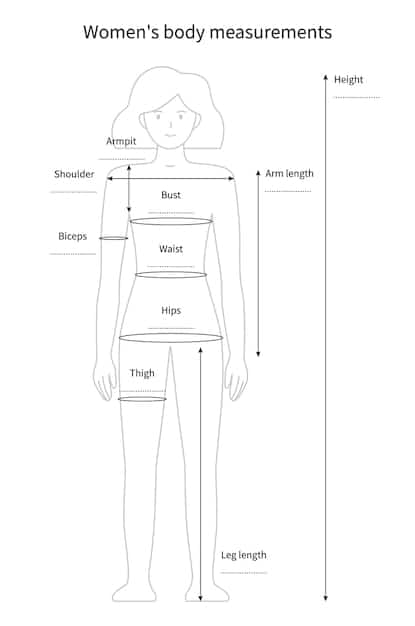Find Your Perfect Fit: The Ultimate Guide to Clothing Size Charts Online

Advertisements
Finding the perfect fit online doesn’t have to be a guessing game; this comprehensive guide to clothing size charts for US shoppers demystifies measuring, interpreting charts, and understanding brand-specific sizing variations to ensure a confident and accurate online shopping experience.
Navigating the world of online clothing shopping can be exciting, but finding the right size can often feel like a gamble. With different brands using varying size charts, how can you ensure that coveted dress or those perfectly tailored jeans will actually fit? This comprehensive guide, how to find the perfect fit online: a comprehensive guide to clothing size charts for US shoppers, will arm you with the knowledge to confidently navigate clothing size charts and make informed purchasing decisions.
Advertisements
Understanding US Clothing Size Standards
The foundation of finding the perfect fit online lies in understanding the landscape of US clothing size standards. While there isn’t a single, universally enforced system, knowing the general principles can greatly improve your success rate.
Size charts are your primary tool, translating body measurements into clothing sizes. However, it’s crucial to remember that these charts are guidelines, and variations are common.
Advertisements
The Reality of “Vanity Sizing”
Be aware of “vanity sizing,” a practice where brands label clothes with smaller sizes than the actual measurements to flatter customers. This can lead to inconsistencies between brands and make online shopping even more challenging.
- What is vanity sizing? It’s when brands reduce the size number on clothing to make customers feel smaller.
- Why does it exist? It’s a marketing tactic aimed at boosting customer satisfaction and sales.
- How does it affect online shopping? It complicates size selection and requires you to rely less on what size you “think” you are and more on actual measurements.
Understanding US clothing size standards requires taking a critical approach to size charts and being mindful of practices like vanity sizing. By focusing on your own measurements and knowing the trends, you will increase your chances of finding clothes that fit well.
Essential Body Measurements for Accurate Sizing
Taking accurate body measurements is the cornerstone of successful online clothing shopping. Forget about the sizes you *think* you are and embrace the tape measure!
These measurements enable you to compare your unique dimensions with the various size charts offered by online retailers.
Key Measurements for Women’s Clothing
For women’s clothing, the most crucial measurements are bust, waist, hips, and inseam. Here’s a breakdown:
- Bust: Measure around the fullest part of your bust, keeping the tape measure parallel to the ground.
- Waist: Measure around your natural waistline, typically the narrowest part of your torso.
- Hips: Measure around the fullest part of your hips, also keeping the tape measure parallel to the ground.
- Inseam: Measure from the crotch down to the desired length of your pants or jeans.
Key Measurements for Men’s Clothing
Understanding essential body measurements is important, and key measurements for men’s clothing include chest, waist, hips, and inseam. Here’s what to know:
- Chest: Measure around the fullest part of your chest, keeping the tape measure parallel to the ground.
- Waist: Measure around your natural waistline, typically the narrowest part of your torso.
- Hips: Measure around the fullest part of your hips, also keeping the tape measure parallel to the ground.
- Inseam: Measure from the crotch down to the desired length of your pants or jeans.
Taking accurate body measurements is about paying attention to detail and using the right methods. With these crucial points in mind, you’ll be well-prepared to confidently compare your dimensions with online retailer’s size charts.
Decoding Different Types of Clothing Size Charts
Size charts aren’t created equal. Understanding the different types of charts you’ll encounter is essential for accurate online shopping.
Different brands will offer a variety of charts for their clothing, so familiarizing yourself with these differences is critical for finding properly-fitting clothing.
Standard Size Charts
These are the most common types of size charts and typically use numerical sizes (e.g., 2, 4, 6) or letter sizes (e.g., S, M, L). They usually include corresponding body measurements in inches or centimeters.
Specific Garment Charts
Some retailers provide charts unique to specific garments, taking into account the design and fit of that particular item.
International Size Conversion Charts
If you’re shopping from international brands, these charts can help you convert US sizes to other sizing systems (e.g., UK, European).

Decoding different types of clothing size charts requires vigilance, adaptability, and a practical approach. By familiarizing yourself with standard charts, seeking garment-specific charts, and using international conversion tables, you’ll greatly enhance your ability to find the right fit when shopping online.
Tips for Using Online Clothing Size Charts Effectively
Mastering the art of utilizing online clothing size charts involves more than just matching your measurements. It requires strategy and attention to detail.
Using simple strategies allows you to approach online clothing shopping in a way that helps you to make better, more confident decisions.
Compare Measurements, Not Just Sizes
Don’t rely solely on the numerical or letter size. Always compare your actual body measurements to the measurements listed on the size chart.
Check for Unit of Measurement
Pay close attention to whether the size chart uses inches or centimeters. Misunderstanding the unit of measurement can lead to significant sizing errors.
Read Customer Reviews
Customer reviews often provide valuable insights into the fit of a garment, including whether it runs true to size, large, or small.
Understanding Fit vs. Size
Size refers to a numerical or letter designation, while fit describes how the garment conforms to your body shape.
Understanding the distinction between fit and size is essential because clothing sizes vary, but style is universal.
Common Fit Styles
Different styles of clothing will fit differently. Some common fit styles are:
- Slim Fit: Closer to the body with narrower cuts.
- Relaxed Fit: Roomier and more comfortable.
- Oversized Fit: Intentionally large and loose.
Understanding the difference between size and fit empowers consumers to make informed purchase decisions that align with their style preferences and body shape. By considering both aspects, shoppers can enhance their confidence and satisfaction with their online clothing purchases.
When to Size Up or Down
There are certain situations where deviating from the size chart can be the right move. Here’s when to consider sizing up or down:
Knowing that sizing up or down can be an effective strategy allows for greater precision in achieving the best fit.
Sizing Up Considerations
You must always consider the size, and here are some things to think about when choosing a size up:
- Between Sizes: If your measurements fall between two sizes, it’s often best to size up, especially for fitted garments.
- Fabric Type: Non-stretch fabrics may require sizing up for comfort.
Sizing Down Considerations
Sizing down is an option to explore. These situations are when to consider sizing down:
- Loose Fit Preference: If you prefer a more fitted look, you might consider sizing down in relaxed-fit styles.
- Stretch Fabrics: Garments made of stretch fabrics often have more give, allowing you to size down.
Knowing when to consider sizing up or down equips shoppers with a deeper understanding of how clothing interacts with their body shape and personal preferences. By combining this knowledge with accurate measurements, you can confidently adapt to variations in clothing design and fabric properties.
| Key Point | Brief Description |
|---|---|
| 📏 Measure Accurately | Use a tape measure to get precise body measurements. |
| 🧐 Check Size Charts | Compare your measurements with the brand’s specific size chart. |
| 🛍️ Read Reviews | See what other customers say about the fit of the garment. |
| 🤔 Consider Fit | Think about how the garment is designed to fit (slim, relaxed, oversized). |
FAQ
▼
Use a flexible tape measure and stand in front of a mirror. Keep the tape parallel to the ground for bust, waist, and hips. For inseam, measure from your crotch to your ankle.
▼
It’s generally recommended to size up, especially for fitted clothing. You can always have it tailored for a more precise fit.
▼
No, clothing sizes are not standardized. Each brand might have slight differences, so always check the brand’s size chart.
▼
Vanity sizing is when brands label clothes with smaller sizes than the actual measurements. To avoid relying on this, measure yourself and compare the sizes to brands.
▼
Most online stores have return or exchange policies. Ensure that you check the store’s policy just in case your clothes do not fit.
Conclusion
Finding the perfect fit online can be a rewarding experience when armed with the right knowledge. By understanding US clothing size standards, taking accurate body measurements, effectively using size charts, and considering fit styles, you can confidently navigate the online clothing market and enjoy a wardrobe that truly complements your unique shape and style.